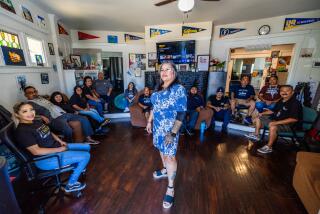Combat Zones
- Share via
Many adults in California cities build daily trips to work and market around guesses about where street gangs will strike next. They map out the day for their children with the care of platoon sergeants in combat. Extraordinary measures, statewide and local, are the only hope for youngsters caught in the crossfire.
Street gangs routinely terrorize sections of Los Angeles, San Diego, Sacramento, San Francisco and Oakland. Authorities estimate gang membership at more than 100,000 statewide. Emboldened by their numbers, they respect neither boundaries nor life--often with results less tragic than injury or death, but tragic nonetheless.
Consider a budding actress, age 11, who wants to attend a magnet school in Los Angeles that emphasizes the performing arts. Her parents, black and affluent, hesitate because of concern over gang activity in the vicinity of the school. The daughter’s dreams are held hostage by gangs.
Consider an athlete, age 17, another youngster of affluence, on his way to a concert. “We’ll read about you tomorrow in the newspaper,” a passer-by warns--simply because the athlete wears a red jogging suit, a color that means trouble when gang rivals are around. The youngster changes into drab gym clothes in his car. The concert is disrupted by gang violence, but he lives through it--perhaps only because of the warning.
It is worst for youngsters who live in gang war zones. Some have died in drive-by shootings while they played at a playground, walked to school or attended a party.
Even when caught at the scene, gang members often manage to escape prosecution by claiming innocence of what their buddies had in mind. Too often the driver of the car in a drive-by shooting gets off with such a claim of innocence, as does the young thug who passes the gun to the triggerman. Prosecutors cannot always prove that accomplices shared the intent to kill.
Assemblywoman Gwen Moore (D-Los Angeles) is trying to find the thin line between the constitutional rights of all Americans, including gang members, and the right of citizens to live in peace. Her bill would would make it easier to prosecute gang members who know that violence is what the gang is about and who also participate in a serious crime. Moore is right to try, and should keep at it, but she has yet to find a balance that would not encroach on the freedom of association.
The California Assembly and Senate have approved different versions of Moore’s bill. The next stop is the Senate Judiciary Committee after the Legislature reconvenes next month. At that point lawmakers should keep looking for language that meets the needs of the Constitution and still would make life harder for the gang members.
Gang terror, once confined to poor ghettos and barrios, is spreading unchecked. The Legislature should take steps to get the toughs off our streets and get innocent youngsters out of the crossfire.
More to Read
Sign up for Essential California
The most important California stories and recommendations in your inbox every morning.
You may occasionally receive promotional content from the Los Angeles Times.










